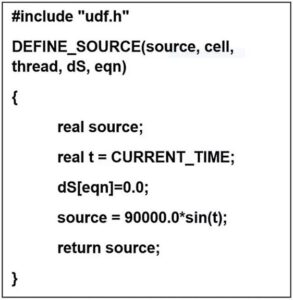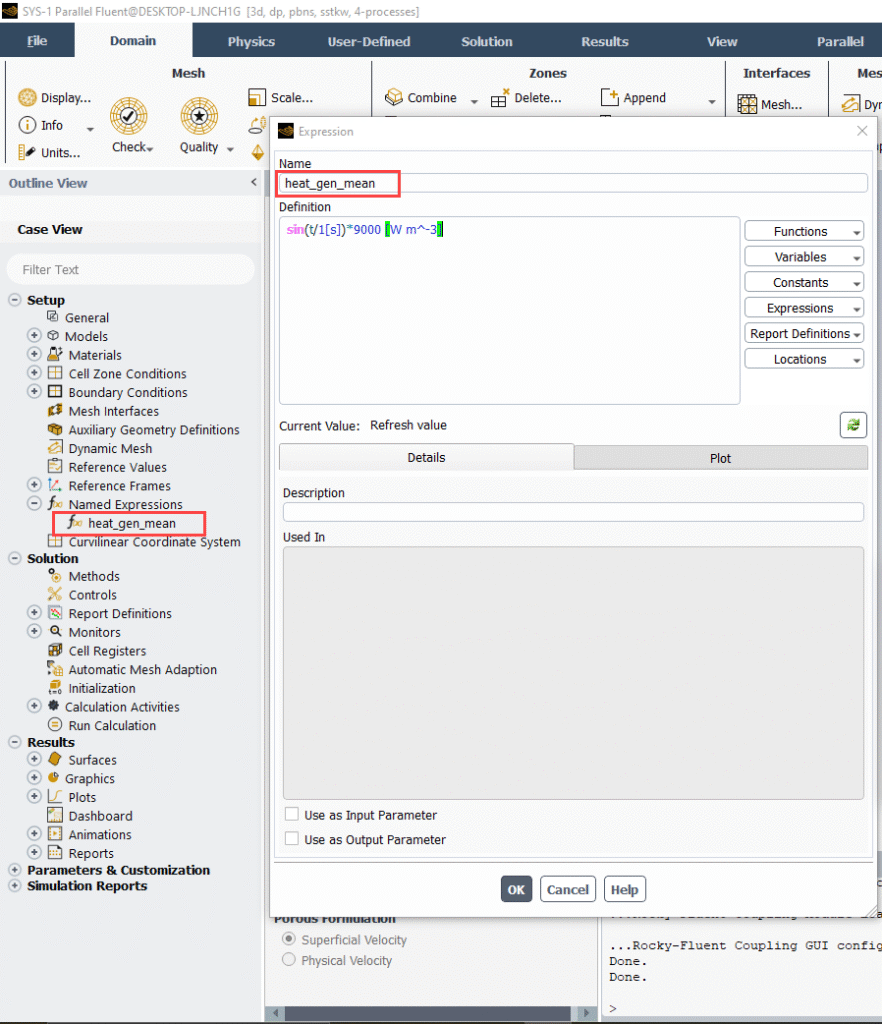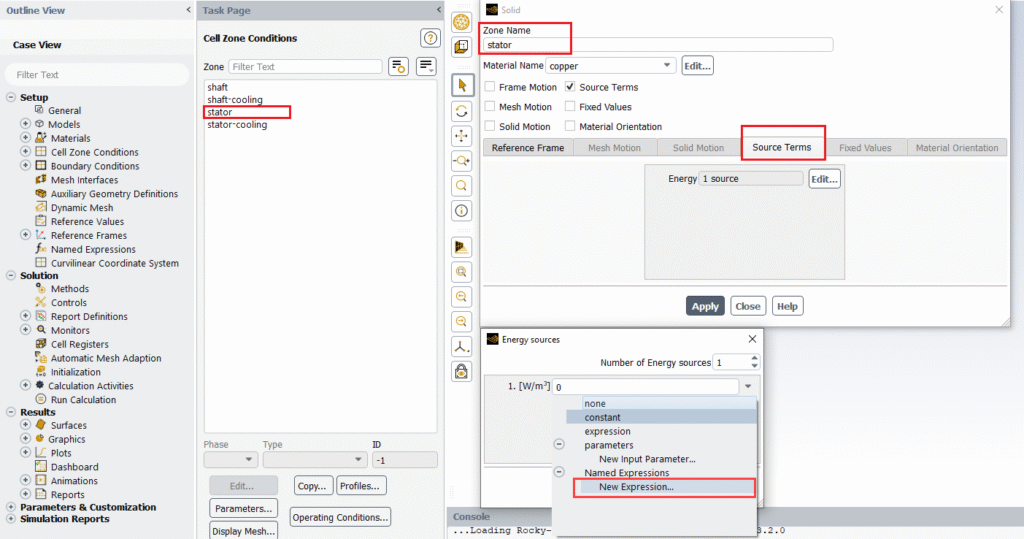Have you ever wondered how to get rid of writing User-Defined Functions (UDFs) in ANSYS Fluent? The good news is that starting from ANSYS 2019 R1, a powerful and exciting feature called the Fluent Expression Language was introduced to make that possible. In the past, even simple tasks—like setting a boundary condition—required writing UDFs in C programming language, dealing with unit conversions, and learning Fluent-specific programming. But now, with ANSYS Fluent expressions, you can define logic, formulas, and custom conditions directly in the User Interface (UI) without writing a single line of code (Fig.1). This study covers everything from using the expression editor, fluent expression example, writing fluent expression if conditions, understanding fluent expression syntax, fixing errors like “expression is not single valued,” to applying report definitions and working with named expressions.
Contents
Toggle
Figure 1- How Expressions in ANSYS Fluent Simplify Our Work
Expressions in ANSYS Fluent
In CFD simulations, there are situations where boundary conditions, source terms, material properties, and other key parameters need to be defined as nonuniform mathematical functions of time or space. These functions may depend on variables from different locations or other aspects of the solution. In ANSYS Fluent, such complex dependencies can be handled using Expressions. ANSYS Fluent User Interface (UI) allow users to customize and organize simulation workflows, define new variables for post-processing, enable parametric studies, and more. For instance, Fig.2 shows you the Fluent UDF code required to set up a sinusoidally fluctuating heat source based on the function Energy(t) = 90000*sin(t) [W/m^3].

Figure 2- Defining a sinusoidally fluctuating heat source based on the function via UDF code
Even a simple UDF, like the one in Fig.2, requires significant effort, including unit conversion, C programming, and learning Fluent-specific concepts. This can be time-consuming even for experienced users. Fluent UI expressions simplify this by allowing users to enhance simulations without writing or compiling UDFs (Fig.3). They enable the use of mathematical functions, logical operators, and fluent field variables to define complex boundary and cell zone conditions more easily.

Figure 3- Defining a sinusoidally fluctuating heat source based on the UI expressions
User Interface (UI) Expressions vs. User-Defined Functions (UDFs)
Overall, UI Expressions are ideal for users looking for quick, straightforward solutions without extensive coding knowledge. They simplify workflows and improve productivity for most common simulation tasks. On the other hands, UDFs are better suited for advanced users who need complete control and customization over their simulations, especially for highly specialized or computationally demanding scenarios. Table 1 shows a comparison between UI and UDF in ANSYS Fluent.
Table 1- Comparison between UI and UDFs in ANSYS Fluent
| Feature | User Interface (UI) | User-Defined Functions (UDFs) |
| Ease of Use | Easy to use, no coding required | Requires programming skills (usually in C) |
| Flexibility | Suitable for common tasks and conditions | Highly customizable for complex scenarios |
| Setup Time | Quick setup using graphical interface | Time-consuming due to coding, compiling, and debugging |
| Learning Curve | Low – suitable for beginners | Steep – suitable for advanced users |
| Applications | Ideal for simple to moderately complex conditions and post-processing tasks. | Best for handling highly specialized or unconventional simulation scenarios. |
If you’re looking for a practical example to learn how to use expressions in ANSYS Fluent, CFD LAND provides a tutorial for this purpose. In “CuO Nanofluid Effect on Cooling Performance Considering Thermal Resistance CFD Simulation, Numerical Paper Validation”, Fluent Expressions are used to calculate thermal resistance, while the UI streamlines setup and analysis. This case shows how CuO nanofluids enhance heat transfer for efficient cooling system design (Fig.4).

Moreover, CFDLAND provides another tutorial for learning how to use expressions in thermal boundary conditions, applied in a real industrial context. The training “Steam Methane Reforming (SMR) Reaction CFD Simulation (2D) – Numerical Paper Validation” focuses on simulating a highly endothermic reaction used for hydrogen production. Since the reaction kinetics do not follow the standard Arrhenius model, a UDF was written to define the custom behavior. Additionally, a temperature gradient at the upper wall—as described in the reference paper—is implemented using an expression in Fluent, making this a valuable example of combining physical accuracy with Fluent’s expression capabilities (Fig.5).

Figure 5- Steam Methane Reforming (SMR) Reaction CFD Simulation (2D) – Numerical Paper Validation
Prerequisites of ANSYS Fluent User Interface (UI)
To effectively learn and use the ANSYS Fluent User Interface (UI), it is essential to have a foundational understanding of the Expression Syntax and the types of variables, such as Field Variables (e.g., velocity, temperature) and Solution Variables (e.g., pressure gradients, turbulence parameters). Additionally, knowledge of Scientific Constants (e.g., thermal conductivity, specific heat) and the use of Aliases for simplifying complex expressions is crucial. Understanding the methods for applying expressions—whether through boundary conditions, cell zone conditions, or post-processing tasks—is equally important to streamline workflows effectively. Beyond these, familiarity with the ANSYS Fluent environment, and an ability to navigate tools like the Expression Editor and Report Definitions will enhance your ability to define and manage expressions efficiently. Following this, we will explore step by step all of the necessary things you should know about ANSYS Fluent User Interface (UI) expressions.
Fluent Expression Syntax
An expression is a string that represents a combination of: Values, Variables, Operators and Function calls. When an expression is evaluated with appropriate values assigned to its variables, it returns a resulting value (which can be a Number, Boolean, or Field).
For example: Vmax * (5.0 * exp(-t – 0.3 [s]/2.8 [s]))
In this expression:
- Vmax is a variable.
- 5.0 is a constant value.
- exp() is a mathematical function (exponential).
- t is a time variable.
- [s] indicates time units (seconds).
- Arithmetic operations like multiplication *, subtraction -, and division / are used.
Expression Data Types
The evaluated result of an expression can be a real number, a Boolean, a real field or a Boolean field. Table 2 depicts types of expression data.
Table 2-Expression Data Types
| Type | Description |
| Real Number | A scalar value like 3.14 or -1.0e-3 |
| Boolean | Logical value: true or false |
| Real Field | 2 * StaticPressure |
| Real Single Values | average(2*StaticPressure, [“inlet”]) |
Expression Values
There are types of expression values as you can see them with their examples in Table 3.
Table 3- Types of Expression Values with example
| Type | Examples | Notes |
| Real Numbers | 1.0, -0.25, 3.2e5 | Standard floating-point numbers |
| Integers | -10, 0, 42 | Whole numbers |
| Boolean Values | true, false | Logical values |
| Quantities | 0.3 [s], 101325.0 [Pa] | Numbers with units in brackets |
All of the following mathematical functions take inputs in the form of an expression that evaluates to a real number or a real field and return a real number or real field:
Operators
Here’s a full summary of common Operators used in ANSYS Fluent expressions (Table 4).
Table 4- Common Operators used for expressions writing
| Operator | Function |
| +, -, *, / | Basic arithmetic |
| ** | Power |
| <, <=, >, >=, ==, != | Comparisons |
❗ Important: Do not chain comparison operators directly. Use logical functions instead, e.g.
AND (StaticTemperature > 300[K], StaticTemperature < 400[K]) ✅
400[K] > StaticTemperature > 300[K] ❌
Mathematical and Logical Functions
Mathematical and logical functions (Table 5) are used to perform basic operations like absolute value, exponentiation, logarithms, etc.
Table 5-Common Mathematical and Logical ANSYS expression list
| Function | Description |
| abs(<expr>) | Absolute value |
| exp(<expr>) | Exponential |
| log(<expr>) | Natural logarithm |
| log10(<expr>) | Base-10 logarithm |
| sqrt(<expr>) | Square root |
| round(<expr>) | Round to nearest integer |
| ceil(<expr>) | Ceiling (round up) |
| floor(<expr>) | Floor (round down) |
| trunc(<expr>) | Truncate |
| mod(a, b) | Modulus |
| max(a, b) | Maximum |
| min(a, b) | Minimum |
| sin(<expr>) | Sine |
| cos(<expr>) | Cosine |
| tan(<expr>) | Tangent |
| asin(<expr>) | Inverse sine |
| acos(<expr>) | Inverse cosine |
| atan(<expr>) | Inverse tangent |
| atan2(<expr1>, <expr2>) | Arctangent of (<expr1>)/(<expr2>) |
| sinh(<expr>) | Hyperbolic sine |
| cosh(<expr>) | Hyperbolic cosine |
| tanh(<expr>) | Hyperbolic tangent |
| asinh(<expr>) | Inverse hyperbolic sine |
| acosh(<expr>) | Inverse hyperbolic cosine |
| atanh(<expr>) | Inverse hyperbolic tangent |
Logical and Conditional Functions
Logical and Conditional Functions in ANSYS are used to perform decision-based operations within expressions, allowing users to apply conditions (like IF, AND, OR) to control the outcome based on logical comparisons. These functions return either boolean values or numeric results depending on the condition, and are essential for region selection, conditional assignments, and adaptive modeling (Table 6).
Table 6- Logical and Conditional Functions Used in ANSYS Expressions
| Function | Description |
| IF(cond, true_val, false_val) | If cond is true, returns true_val, else false_val |
| AND(expr1, expr2, …) | Logical AND |
| OR(expr1, expr2, …) | Logical OR |
| XOR(expr1, expr2) | Exclusive OR |
| NOT(expr) | Logical negation |
Reduction Functions
Reduction Functions in ANSYS (Table 7) are used to compute summary values—such as average, maximum, minimum, sum, area, or volume—over specified regions or zones in the computational domain. They help extract global or regional insights from field data.
Table 7- Reduction Functions in ANSYS Expression Syntax
| Function | Description |
| Area([location]) | Returns the area of a region |
| Volume([location]) | Returns the volume of a region |
| Average(expr, [location], Weight=None|”Area”|Volume”) | The average of the expression over the specified region. |
| Maximum(expr, [location]) | Maximum value over specified region |
| Minimum(expr, [location]) | Minimum value over specified region |
| Sum(expr, [location], Weight=None|”Area”|Volume”) | The total of the expression over a region. |
Vector Operations
Vector Operations in ANSYS (Table 8) allow users to access specific components (x, y, z) or the magnitude of a vector field such as velocity or force, enabling detailed directional analysis and calculations.
Table 8- Vector Operations in ANSYS Expressions
| Syntax | Description |
| Velocity.x | x-component of the vector |
| Velocity.y | y-component of the vector |
| Velocity.z | z-component of the vector |
| Velocity.mag | Magnitude of the vector |
Field Variables in ANSYS Fluent
In ANSYS Fluent, field variables refer to physical quantities that vary across the computational domain—such as velocity, pressure, temperature, species concentration, etc. These variables are essential for postprocessing and can also be used directly in expressions to define custom functions, conditions, or field-dependent inputs. Some variables require additional context, which is specified in the following format: Variable (<context>=”<context value>”).
- To get the species mass fraction of carbon dioxide. For example:
MassFraction (species=”co2″)
- In multiphase simulations, the phase context must be specified. For example:
MassFraction (species=”co2″, phase=”air”)
Important Notes:
- Context must be explicitly specified using named parameters like species, phase, or mixture.
- Variables like pressure, temperature, and velocity typically do not require context.
- Multiphase simulations (VOF, Eulerian, etc.) must include the phase context when accessing phase-specific properties.
Solution Variables in Fluent
Solution variables are global simulation values representing time, iteration, or timestep-related information (Table 9). These are accessible during the simulation and can be referenced in custom expressions, conditionals, or user-defined operations.
Table 9- Available Solution Variables in ANSYS Fluent
| Variable | Description |
| Time | Returns the current simulation time. In steady-state, it evaluates as 0, unless the case was previously run as transient, in which case it retains the last transient time. |
| Timestep | Returns the current timestep number. Same as above — 0 in steady-state unless switched from transient. |
| DeltaTime | Returns the time step size used in the current iteration. Again, 0 in pure steady-state unless continued from transient. |
| Iteration | Returns the global iteration count (i.e., how many solver iterations have occurred). |
Important Notes:
- In steady-state simulations, Time, Timestep, and DeltaTime will return 0 unless the simulation was previously run in transient mode and then switched to steady. These variables are especially useful for:
- Creating time-dependent expressions (e.g., oscillating sources).
- Triggering changes based on iteration number.
- Controlling time-based boundary conditions or sources.
Example Use in Expression
sin(2*pi*Time/5.0) → for a periodic input with a 5-second period
IF(Iteration > 1000, 1, 0) → activates a feature after 1000 iterations
Scientific Constants
Scientific constants are predefined physical values like π, e, the gas constant (R), and gravitational acceleration (g) that are universally accepted in scientific and engineering calculations. They ensure accuracy and consistency in mathematical models, simulations, and real-world problem solving. Table 10 provides a comprehensive scientific constants which are important in writing of ANSYS Fluent expressions.
Table 10- Fundamental Scientific Constants
| Variable | Description | Value |
| PI | Pi | 3.14159265358979323846 |
| e | e (base of the natural logarithm) | 2.71828182845904523536 |
| R | Gas constant | 8.314472 [J K^-1 mol^-1] |
| avogadro | Avogadro’s number | 6.02214199e23 [mol^-1] |
| boltzmann | Boltzmann constant | 1.3806503 [J K^-1] |
| clight | Light velocity | 2.99792458e8 [m s^-1] |
| echarge | Electron charge | 1.60217653e-19 [A s] |
| g | Acceleration due to gravity | 9.8066502 [m s^-2] |
| planck | Planck’s constant | 6.62606876e-34 [J s] |
| stephan | Stefan-Boltzmann constant | 5.670400e-08 [W m^-2 K^-2] |
| mupermo | Magnetic permeability of free space | 4.0*PI*1.0e-7 [N A^-2] |
| epspermo | Electric constant | 1./(clight*clight*mupermo) |
Aliases
Aliases provide simplified syntax to access frequently used variables (Table 11).
Table 11- Types of available variable in ANSYS Fluent and the corresponding Aliases
| Variable | Alias to |
| x | Position.x |
| y | Position.y |
| z | Position.z |
| u | Velocity.x |
| v | Velocity.y |
| w | Velocity.z |
| iter | Global iteration count |
| T | StaticTemperature |
| P | StaticPressure |
| mf | MassFraction |
| Amag | FaceAreaMagnitude |
| vol | CellVolume |
| mass | CellVolume*Density |
| t | Time* |
| dt | DeltaTime** |
Important Notes:
- *In steady state, time (t) evaluates as 0, unless the case was run in transient, then switched to steady state, in which case it will evaluate as the latest time from the transient run.
- **In steady state, delta time (dt) evaluates as 0, unless the case was run in transient, then switched to steady state, in which case it will evaluate as the latest delta time from the transient run.
How to Use Expressions in ANSYS Fluent
There are two primary methods for creating and using expressions in the software:
Direct Input
Direct Input is quick and convenient for one-time use. In this method, you can write the expression directly in the required field (e.g., boundary condition, source term, monitor, etc.). Here, as an example, you will see step by step how to define an expression for a boundary condition.
Step1: Selecting the Boundary Conditions (here, the target B.C. is Velocity inlet)
To navigate to field variables in ANSYS Fluent, go to Setup in the Outline View, select Boundary Conditions, and choose the desired boundary (e.g., Inlet) (Fig.6). In the Task Page, under the appropriate tab (e.g., Momentum), you can define variables like Velocity Magnitude using predefined values or expressions by clicking the function icon (f(x)).

Figure 6- Navigation in ANSYS Fluent to Select Velocity Magnitude at an Inlet Boundary
Step2: Selecting the ANSYS Fluent expressions for setting the Boundary Condition
Click the drop-down arrow to the right of the field that you would like to define using an expression and select expression (Fig.7). Now, you can enter your expression directly in the text field. For example, Fig. 8 illustrates how you can set Velocity Inlet boundary condition via in ANSYS Fluent expressions.

Figure 7- How to enable expressions for setting the Boundary Condition

Figure 8- Setting the aim Boundary Condition within the expression editor Dialog Box
As shown in the Fig.8, the Velocity Magnitude is defined using a time-dependent function, and The Reference Frame is set to Absolute:
Velocity Magnitude= 0.2 [m/s] * sin (2 * t * π / 1[s])
- The velocity magnitude is defined as a sinusoidal function of time.
- 2 [m s^-1] is the amplitude of the velocity.
- sin(2*t*π/1 [s]) represents a sine wave with a frequency of 1 Hz.
- [m s^-1] specifies the velocity unit.
- [s] indicates the time unit.
Named Expression (Indirect Input)
Creating a Named Expression separately using the Expressions panel, allows you to assign a name to the expression and reuse it in multiple locations throughout the model, ensuring consistency and ease of updates. Referring back to Fig. 3, this example demonstrates step by step how to define it as an expression function.
Step1: Creating a Named Expression for Reuse in ANSYS Fluent
Firstly, go to Setup and expand the Named Expressions section. Right-click on it and select New to create a new expression (Fig.9).

Figure 9- Navigation in ANSYS Fluent for Creating a new named expressions
Step2: Defining and Saving a Named Expression in ANSYS Fluent
Next, you should define the Named Expression by entering a name (e.g., heat_gen_mean) and specifying its mathematical formula or definition. You can use functions, variables, constants, or other expressions to build the definition. Once created, this expression can be reused in various parts of the simulation, then click OK to save it. Fig.10 shows a sinusoidally fluctuating heat source based on the time function:
Name = sin(t/1[s])*90000 [W/m^-3]

Figure 10- Defining and Saving a Named Expression in ANSYS Fluent
Step3: Using the Named Expression in a Boundary or Cell Zone
In Step 3, apply the created Named Expression in relevant simulation settings (here is stator). Then in the Cell Zone Conditions panel, navigate to the Source Terms, and for parameters like Energy Source, select Named Expressions from the dropdown (Fig.11).

Figure 11- How to enabling the Named Expression, which is defined before, for a Boundary or Cell Zone
Step4: Activating the desired expression
Choose the desired expression, and click OK to use it in the simulation (Fig.12).

Figure 12- Activating the desired expression for keeping the simulation procedure
Context Specification
Some variables require additional context before they can be evaluated. For example, MassFraction requires the species context. Velocity may require phase context when it is evaluated in a multiphase simulation. The context is specified as a keyword argument to a function call on the variable. For example, MassFraction(species=”co2″, phase=”smoke”).
Supported Field Variables
In ANSYS Fluent, field variables represent physical quantities that can be accessed or manipulated during a simulation. These variables are essential for defining boundary conditions, post-processing, or writing custom User-Defined Functions (UDFs). Below you can see some examples of the field variables shown in the Table 12. It should be noted that ANSYS Fluent expressions supports a wide range of Field Variables; therefore, user can search for and utilize the specific variables needed for their simulations.
Table 12- Example of Field Variables suported in ANSYS Fluent
| Description | Variable (type/context) |
| Absolute Pressure | AbsolutePressure (scalar) |
| Absolute Radiation Flux | AbsoluteRadiationFlux (scalar) |
| Axial Velocity | Axial Velocity AxialVelocity (scalar) |
| Cell Weight | CellWeight (scalar) |
| Density | Density (scalar) |
| Mass fraction of %s | MassFraction (species=”<species>”) |
| Dynamic Pressure | DynamicPressure (scalar) |
For instance, Absolute Pressure (AbsolutePressure (scalar)), Represents the total pressure at a given point in the domain, including static and dynamic components. It is a scalar value commonly used for pressure-based calculations, boundary conditions, or monitoring.
Conclusion
The ANSYS Fluent Expression Language simplifies simulation setup by eliminating the need for coding with UDFs. Using the ANSYS Fluent expression editor, users can define custom logic through built-in variables, constants, and functions. The fluent expression syntax supports conditional statements like ansys fluent expression if, enabling dynamic control of simulation parameters. Learning how to use expressions in ANSYS Fluent and how to enable the expressions in FLUENT empowers users to apply reusable, flexible conditions. With access to the full ansys expression list, Fluent expressions improve both workflow efficiency and model accuracy.
FAQs
- What is the ANSYS Fluent Expression Language?
It’s a built-in feature that lets users define custom logic, formulas, and conditions directly in Fluent without writing UDFs.
- How do I enable expressions in ANSYS Fluent?
Click the f(x) icon next to input fields (e.g., velocity or energy), then select “Expression” to enter or choose your formula.
- What is the difference between direct input and named expressions?
Direct input is used for one-time expressions, while named expressions are reusable and created via the ANSYS Fluent expression editor.
- What’s the main difference between expressions and UDFs?
Expressions are simpler, require no coding, and are good for common tasks. UDFs (User-Defined Functions) need C programming and offer more flexibility for complex or custom simulations.
- Can Fluent expressions replace UDFs?
Yes, for many standard tasks like time-varying boundary conditions or logical controls. UDFs are still needed for advanced or highly customized behavior.
- What is the fluent expression syntax like?
It combines values, variables, operators, and functions. Example: 0.2 [m/s] * sin(2 * t * π / 1 [s]).
- Do I need programming knowledge to use Fluent expressions?
No. Fluent expressions use an intuitive interface and require no coding, unlike UDFs which require C programming.

